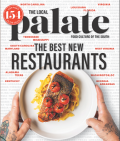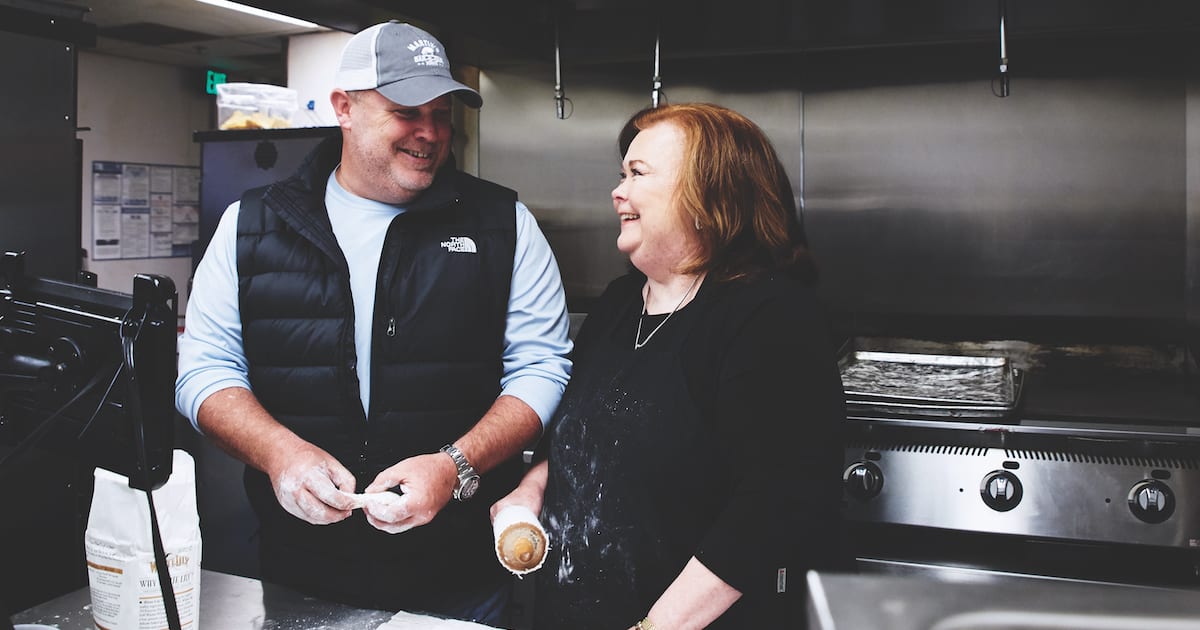When Pat Martin wanted to offer a new dessert at his barbecue empire, he knew just where to turn
A neon pig spins like a honky tonk disco ball above Martin’s Bar-B-Que Joint in downtown Nashville. And inside, the space is no less lit—Waylon booms from the sound system as tourists in cowboy boots mix with locals in Preds gear under a hickory haze creeping low like a stratus cloud from the pit room.
The 13,000-square-foot space with a lush outdoor beer garden is one of six locations by pitmaster Patrick Martin, who also owns Hugh-Baby’s, a burger joint with a second location in the works. Martin’s journey has been sprinkled with national television appearances and invites to prestigious barbecue events like New York City’s annual Big Apple BBQ Block Party. But it all began simply with his first joint, a tiny rustic space that shared walls with an auto body shop. And when it comes to breads and desserts, Martin still only trusts one cook among them all: his mama.
From 2006 to 2010, Pam Martin made pecan pies and coconut cakes every two weeks for the restaurant. She tested biscuits for the Belmont Avenue location (they decided not to add them to the menu), and improved the quality of his hushpuppies. As Martin added locations, Pam’s baking duties waned. But recently, Martin got the urge to add fried pies to the menu and asked her to bake with employees to teach them how it’s done. “My mom is my first phone call, my go-to,” he says. Pam offered to come in for a few days. “Unless he wants to put me on the payroll,” she jokes.
Why Fried?
Fried pies aren’t necessarily a Nashville thing. You won’t find recipes for them in Junior League of Nashville cookbooks or Minnie Peal Cooks. But they’re famously offered in just a few other places in town. The Dairy King has hawked chocolate fried pies for more than 40 years. Martin’s friend Carey Bringle of Peg Leg Porker says his fried pies are “like making sex on a rainbow.” And at Ooh Wee Bar-B-Q, a curb-service trailer off Jefferson Street, the owners pay homage to Mayo’s Fried Pies and Mahalia Jackson’s Chicken, which used to be located at the space. Ooh Wee’s owner found a former employee of the fried pie institution and paid him a hundred bucks to teach his wife the recipe. He sells pies bulging with sweet potato, apple, and peach fillings wrapped in wax paper. “Southern people—country Southern people—love fried pies,” Martin says.
In John Egerton’s book Side Orders: Small Helpings of Southern Cookery & Culture, the late Nashville-based author posited that fried pies are a treat from mountain people who learned to preserve their harvest of peaches and apples by drying them in the sun and stewing them to fold between pastry. “Back during the depression, dried apples and peaches were a mark of frugal stewardship in many a Southern country home,” Egerton wrote.
Pat says the cooks in his family made fried pies in Mississippi where he grew up, but not too often. “They didn’t screw around much with fried pies,” he said. “It was more triple-layer coconut cakes.” But he does remember his grandmother Nadine King’s pies made from her apple trees, and he also found inspiration for the pies in the old burger restaurants and barbecue joints where he learned and fell in love with his craft. Plus, he says he wanted them on the menu as a hand-held sweet. “You don’t even feel like you’re eating dessert,” he says.

In the Kitchen
“You’ve gotta take care of that back,” his mother tells him from the downtown kitchen, or “backstage” as it were. Martin injured himself in a boating accident off the coast of Honduras. Even though he towers over her as she rolls out dough for fried pies, there’s no question who’s boss.

Mama Martin shrugs it off saying she makes fried pies just about twice a year. But her hands tell a different story. She works with a wooden rolling pin covered in a floured pastry sleeve. It was a wedding gift from her husband Danny’s grandmother forty-eight years ago. And while she prepares the dough she uses for all her pies, she reduces the shortening to make a less flaky and sturdier pie that can hold up in a fryer. She arrived that morning with various types of fruit fillings, extra ingredients, and scribbled notes for the three dough versions she plans to test and tweak.
“They’re natural pastry chefs,” Martin says of his relatives. “I don’t think they even know what that means. But they know how pastry works. They all do it by feel.”
It’s knowledge that comes from both sides of the family. While Pam was schooled in baking by her father’s mother, Alma King, who cooked without recipes, she also learned from her mother-in-law, Nonie Martin. Known in Northern Mississippi for her yeast rolls, biscuits, cakes, and fried chicken, Nonie Martin’s recipes had been legendary in the Church of Christ cookbooks. “She was so good even the Baptists and Methodists put it in their books,” Martin says. “Her rolls made it into everyone’s books.”
Finding the Perfect Pie
As Pam scoops flour and tosses in salt, Grace Johnston, a Martin’s project manager overseeing R&D, follows behind her, weighing ingredients on a kitchen scale and taking down precise measurements and notes. Pam worked at home on the recipes for several days, and spends two days with Johnston, at least six hours per day, to make about 350 pies searching for the perfect version.
The process is at times both meticulous and intuitive. Pam rolls dough onto a pastry cloth she stores neatly folded in a Ziploc bag. Then she uses a red plastic bowl to cut out circles of dough, a fill-in for her usual lid from the Crisco container, which she left back in Memphis. “I couldn’t just go off and leave my Crisco uncovered,” she says. Pam fries at home in a skillet without a thermometer instead of the commercial deep-fryer they used at the restaurant, so she needs to test oil temperatures and times. The pies need to be turned out in bulk but quickly and consistently.
And that’s just the dough. The testing extended to fillings too, which results in saucepans of bubbling fruits in deep jewel tones over the stove. They settle on peach, raspberry, blackberry, and chocolate. “What about canned [peaches]?” Johnston suggests, thinking of time and costs. Pam raises her eyebrows and shakes her head. She recommends beginning instead with dried peaches—concentrated in flavor and simmered slowly in water to soften before adding sugar— just like her grandmother and mother had done with dried apples from the trees in their yards.

The Making of a Barbecue Man
Pat Martin’s parents say they’ll never forget visiting their son’s first barbecue restaurant on opening night more than ten years ago. “There were cars everywhere,” his father, Danny says. “We had no idea what to expect. We weren’t late, but they were already running out of food,” Pam adds. “I never dreamed… I didn’t recognize the creativity he had.” But Martin did show early signs of entrepreneurship.
Growing up he ate meat and not much else. No casseroles. No vegetables. Pam would fry chicken strips and send him off with them in sandwich bags. “If you can make some extra of those,” he told her when he was only in about the fourth grade, “I can sell them for twenty-five cents.” As time passed, he began hanging around Danny by the grill and a few years later made friends with a boy whose father liked to cook. He came home with a recipe for a shrimp dish and proclaimed he would make it for the family. “I’m thinking, ‘oh gosh, what is my kitchen gonna look like,’” Pam says.
He left for college in West Tennessee with his mother’s wok in tow for making meals in the dorm room. Then, he discovered whole hog. He learned by hanging out with the old-time pitmasters in Henderson. By the 1990s, the family’s catfish fries on Pam’s folks’ property in Mississippi had morphed into pig roasts. Pam would organize desserts and side dishes while her son ran the hog operation. “I don’t know anything about cooking a pig,” she says, ‘except low and slow.’”
He cooked whole hogs with just a set of concrete blocks, coals, a grate and a piece of tin to cover the animal, and he cooked them as often as he could for friends, family, and social clubs. Once while working an internship with Merrill Lynch in Chicago (he was a bonds trader in his first career), he hauled all the whole hog trappings up to cook for his boss and co-workers. “I’m sure that was a surprise,” Pam says.
And while she did not teach him about the art of smoke, she can’t help but think he picked up a love and intuition for food from both upbringing and DNA. “You never know what you’re teaching your child,” she says. “We celebrate life by getting together and cooking big meals and eating. I’m sure that’s one way he found his love for food.”
Fried and True
As Pam and Johnston lift their experimental pies from the fryer to cool on sheets of butcher paper, employees who zip through the kitchen pause to ogle or offer their services as tasters. One of Martin’s protégés pauses from his labor at the pits to bite into a hot pie oozing with inky blackberry while standing over a kitchen sink. He flashes Pam a smile and thumbs up. Meanwhile, though, Martin has other restaurants to visit and a doctor’s appointment to take care of his back as his mother had instructed. “Mom, thank you. I love you,” he says quickly yet sincerely. And then he bolts out the back door.
Pam Martin’s Fried Peach Pies
share
trending content
-
6 Things to Do Beyond Golf in Pinehurst
by TLP's Partners -
Charlottesville, Virginia Named Wine Region of the Year
-
A New Home for Lazy Betty
by Lia Picard -
Will Travel for Southern Food
by TLP Editors -
In the Spirit: Never Say Die Bourbon
by Amber Chase
More From Dining Out
-
A New Home for Lazy Betty
-
Our Top Restaurants of 2023
-
50 Years of Family Recipes at Sperry’s
-
Where to Eat and Drink in WeHo
-
A Halloween Night with MACHETE






